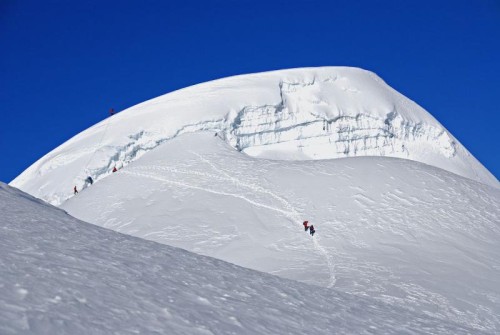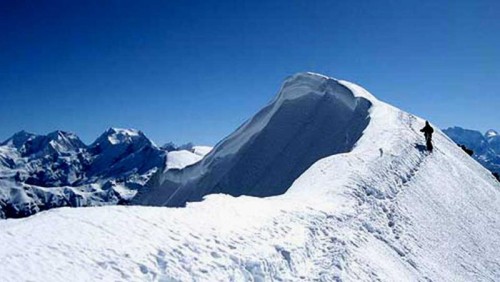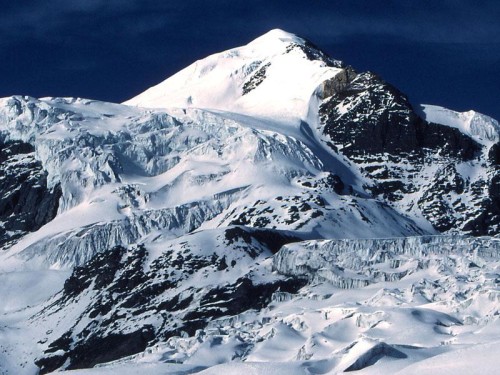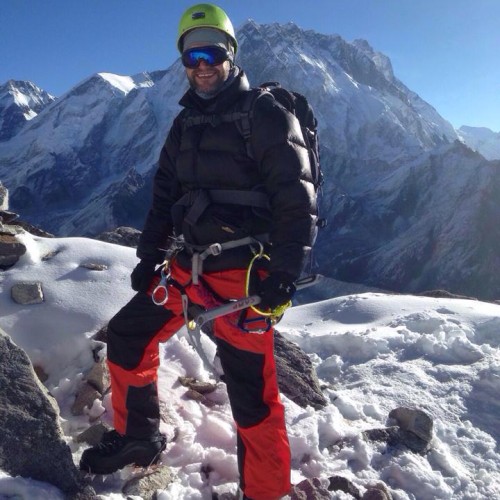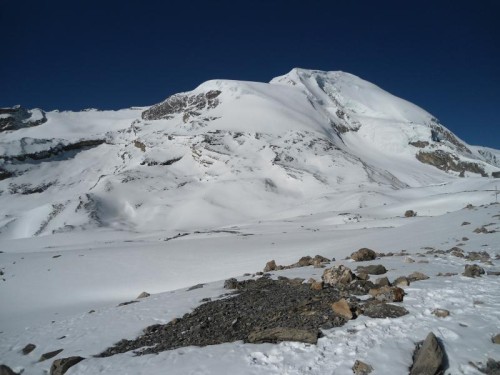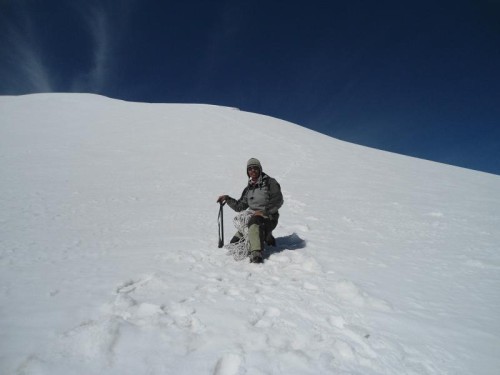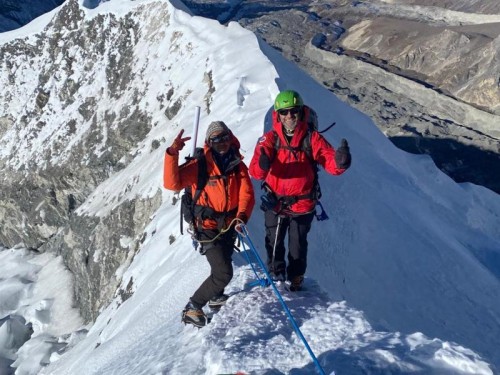Climbing Yala Peak
Yala Peak is not a technically demanding climbing peak because its height is only 5,520 meters. However, climbers may find it difficult to ascend due to the high-altitude rocky and icy terrain, as well as the lower oxygen levels. Therefore, an extra acclimatization day and additional energy are needed. Additionally, you should take care of your hydration and maintain a slow, manageable pace.
The climb starts from Yala Peak Base Camp, which is at an altitude of 5,000 meters, where climbers stay in tented camps. There, climbers usually receive training from the climbing guide on essential climbing skills, including the use of climbing equipment, walking with crampons, and handling the main rope. This basic training is especially important for first-time climbers.
To climb Yala Peak, you will first walk for a few hours on rocky terrain, followed by the final couple of hours on a glacier and ice. This part is a bit challenging due to the high elevation, so you need to maintain your own pace for safety and be prepared to self-arrest using your walking axe if necessary. From the summit, the panoramic views include Langtang Lirung (7,246m), Dorje Lakpa (6,990m), Gangchempo (6,388m), Shishapangma (8,027m), and other surrounding snow-capped peaks.
Yala Peak Climbing Difficulty
The Yala Peak Trek and climb are generally considered to be less technically difficult compared to other peaks like Island Peak and Lobuche Peak. However, it still requires physical fitness, making it suitable for climbers of all levels, including beginners, if they are properly prepared.
The trek and climb involve some steep ascents and descents, with daily walks averaging 5-8 hours through varying terrain, including forests, rugged paths, and rocky and icy sections. Altitude is a factor to consider, as the trek begins at 1,600 meters in Syabrubesi and reaches its highest point at 5,520 meters at the summit of Yala Peak. Proper preparation, such as walking and other hiking-related exercises, is important.
Our Yala Peak Climbing package is carefully designed by our experienced trekking and climbing guides, making this itinerary suitable for all travelers. Acclimatization days are included to help adjust to the altitude, and at the base camp of Yala Peak, our climbing guide provides basic climbing training for successfully complete the trip.
Best Season for Yala Peak Climbing
The best seasons for Yala Peak Climbing are Spring (March–May) and Autumn (September–November). These seasons offer stable weather, clear skies, and safer climbing conditions, making them the most favorable times for climbers to summit this 5,520m peak in the Langtang region, each offering unique features for the climb. However, the best months are May and October.
In the Spring season (March–May), stable temperatures and clear weather make climbing conditions ideal. The risk of snowfall is lower than in winter, making the ascent easier. Longer daylight hours allow for more flexible climbing schedules. This is the best season for first-time climbers, as conditions are more forgiving. The landscape is beautiful, with blooming rhododendrons and lush greenery at lower altitudes.
The Autumn season (September–November) offers crystal-clear skies and unmatched mountain views. Minimal precipitation and stable weather make climbing conditions predictable. The trails and summit approach are drier, reducing the risk of slippery terrain. It's the perfect time to combine Yala Peak with the Langtang Valley Trek.
In the Winter (December–February), it is not recommended due to extremely cold temperatures (as low as -20°C or lower at high camps). Heavy snowfall can block routes, making climbing dangerous. Short daylight hours limit the available climbing time.
Monsoon (June–August) – Not recommended due to frequent rainfall, which leads to muddy and slippery trails, poor visibility from cloud cover, and an increased risk of landslides and avalanches in the Langtang region.
So, it is important to choose the ideal trekking and climbing season for your Nepal adventure based on your availability and personal preferences.
Accommodation on the Yala Peak Climbing
Accommodation on the trek, before and after climbing Yala Peak, is in comfortable lodges, as the region is the third most popular trekking destination in Nepal after the Everest and Annapurna regions. These lodges are run by local families. However, during the climbing period, accommodation is in tented camps.
There are numerous accommodations and restaurants along the trekking trail, except at Yala Peak Base Camp, as new lodges are built every year to accommodate the increasing number of trekkers. Therefore, finding comfortable accommodation in the Langtang Valley is easy.
Almost all tea houses (lodges) strive to provide the best service for travelers. Typically, lodges offer private rooms with two beds, mattresses, blankets, and pillows. However, we highly recommend bringing a warm sleeping bag for tent camping.
Bathrooms are shared indoors, and most lodges have gas-powered showers. While some still use traditional ‘drop’ toilets, many now have flush systems. Each lodge has a central communal dining area with a stove for warmth. The quality of lodges varies by location, allowing you to choose the best option based on your budget.
Food on the Yala Peak Climbing
Food on the trek is of good quality, offering a mix of local Nepali dishes and Western-style recipes. Each lodge has a food menu, with most offering similar options. The traditional Nepali meal, Dal Bhat (boiled rice, vegetables, and lentil soup), is a common choice, but you can also find other items such as momos, pasta, noodles, potatoes, soups, bread, chips, eggs, pancakes, and porridge.
While the family cooks are trained, the taste of the food may differ slightly from Western cuisine. Fresh meat is not readily available in the mountains, so opting for vegetarian meals is advisable during the Langtang Valley Trek and Yala Peak Climbing.
You can purchase various snacks and drinks at lodges, though prices increase as you ascend. For drinking water, normal water can be consumed using purification tablets. However, it is recommended to avoid alcoholic beverages at higher altitudes to prevent altitude sickness.
Required Permits for Yala Peak Climbing
For climbing Yala Peak (5,500 meters) in the Langtang region, special climbing permits are not required for climbers. However, trekkers need trekking permits to enter the Langtang Region. To enter the Langtang region, you will need to purchase the Langtang National Park Permit, which costs NPR 3,000 ($25) for all foreign trekkers, but for some nationalities, it’s only NPR 1,500. This permit can be purchased from the Nepal Tourism Board at Bhrikuti Mandap in Kathmandu or from Dhunche, which is on the way to Syabrubesi.
Another permit required is the TIMS card (Trekkers' Information Management System), which ensures safety for trekkers, guides, and porters during trekking and climbing. This card is arranged by a local trekking agency through the Nepal Tourism Board in Kathmandu or Pokhara. The cost is currently NPR 2,000 (approximately US$20).
Yala Peak Climbing Cost
The cost of Yala Peak Climbing in the Langtang Region depends on various factors, such as group size, type of package, duration of the trek, and time of year. For a 13-day Yala Peak Climbing trip (including trekking and climbing days, as well as three nights' stay in Kathmandu before and after the trip), the total cost per person ranges from USD 1,200 to 2,000, depending on the level of service, group size, and specific arrangements. This cost is for an all-inclusive package that includes permits, guides, climbing guide, accommodation, transport, and meals. If we break down the costs for guide, porter, transport, accommodation, and meals separately, the total cost would be more expensive than the all-inclusive package.
Yala Peak Trek and Climb Support Team - Guide and Porter
Yala Peak Climbing is more challenging than trekking in Nepal because Yala Peak is located in a remote area. To ensure a safe and successful climb, we carefully manage experienced and professional guides and climbers. It is essential to hire a trekking guide, a climbing guide, and a strong porter to complete the trip successfully.
The trekking guide will explain the culture, nature, and trails, while the climbing guide will provide instructions on climbing techniques. The porter will carry your trekking and climbing gear, allowing you to focus solely on your trek and climb while ensuring a safe journey.
We provide proper equipment and insurance coverage for all our trekking staff, including guides, climbing guides, porters, and local staff, in case of an accident or the need for emergency evacuation.
Porters will carry your main bag, with a maximum weight limit of 15 kg, and will cater to the group's needs. Additionally, your guide and climbing guide will be with you throughout the journey to ensure your safety and a memorable experience.
Yala Peak Climbing Travel Insurance for Emergency and Evacuation- Policy
The Himalayan climate is constantly changing, and since you are coming from a different region, there is a risk of high altitude sickness and potential mishaps. If a person is severely injured or suffers from altitude sickness, they may need to return by foot, horse, or helicopter, depending on their health condition.
If the situation does not require immediate helicopter evacuation, there are many local clinics available for treatment, and horses are commonly used for transportation when needed. In cases of altitude sickness, the best advice is to avoid taking risks by ascending further. Instead, descending to a lower altitude is necessary, and our team will fully facilitate this process.
If a person is unable to walk, helicopter evacuation will be required for a quicker transfer to the city. Therefore, it is essential to have travel insurance that covers helicopter evacuation and other necessary transportation.
Your travel insurance must include coverage for air ambulance services, medical care, and any travel-related risks, such as delayed flights, and lost, stolen, or damaged baggage. Additionally, ensure that your insurance policy covers trekking above 5,500 meters. If not, you will be responsible for any unforeseen costs during your trek in Nepal.
All trekkers must provide a copy of their comprehensive travel insurance certificate to High Pass Adventure as part of the booking process for trekking and climbing in Nepal. This is necessary because we assist in arranging emergency services through your insurance if needed.
Tipping information
The trekking and climbing guides, as well as the porters, play a crucial role in ensuring a smooth and successful trip. After completing the journey, they gratefully accept tips from trekkers and climbers.
Tipping is an important aspect of trekking in Nepal, as it acknowledges and appreciates the hard work of the local staff who support you throughout your adventure. It is customary to tip at the end of the trek, and you should gather all team members— including the guide, porter, and assistant guide— to distribute the tips fairly.
Tips are generally given in cash, preferably in US dollars or Nepalese rupees. It is best to use small denominations to facilitate easier distribution. While the typical guideline is to tip around 15 to 20% of the total payable amount, you can adjust this based on the quality of service provided.
- Recommended tipping amounts are as follows:
- Guide: $12-$15 per day
- Climbing Guide: US$ 10-12 per day
- Porter: $8-$10 per day
- Assistant Guide: $8-$12 per day
These tips are highly recommended to motivate the team and reward them for their outstanding service, contributing to a memorable and inspiring experience.
Required packing list for Yala Peak Trek and Climb
Travel equipment is essential to pack before your trip. Below is the recommended packing list. We understand it may seem like a lot to carry from home, so we suggest packing light and bringing only the necessary items. If you’re missing something, you can hire or buy it in Kathmandu, especially around Thamel.
These general items are suitable for all seasons while trekking in Nepal, but the list may vary depending on the season and the duration of your chosen trek. Therefore, it’s important to ask your trekking organizer for a detailed packing list specific to your trek. They will provide you with clear information about what to bring.
Climbing gears
- Climbing Boots:Should be insulated, waterproof, sturdy, and good ankle support
- Crampons:Make sure, compatible with your climbing boots and in good condition.
- Ice Axe:A basic ice axe is essential for traversing snow and ice sections.
- Harness:A comfortable and adjustable climbing harness is necessary for safety.
- Helmet:A climbing helmet to protect your head from falling rocks and ice.
- Ropes:You might need a rope for glacier travel and crevasse crossings. It will be provided by your trekking agent.
- Carabineers:A mix of locking and non-locking carabineers for various purposes.
- Ascenders and Descenders:These are used for ascending and descending on ropes
Climbing clothes
- Base Layers:Moisture-wicking base layers (both top and bottom) to keep you warm and dry.
- Insulating Layer:A good quality fleece or down jacket for warmth
- Outer Layer:A waterproof and windproof shell jacket and pants.
- Gloves:Layered gloves including thin liners and thick, insulated gloves for cold weather.
- Hat and Balaclava:For warmth and protection against the cold.
- Gaiters:To keep snow and ice out of your boots.
Necessary Trekking gear
- Sleeping bag (Comfort rating -15 Celsius recommended)
- Sleeping bag liner (Optional)
- Trekking boots: one pair lightweight
- Sandals for city and tea house footwear
- Shoes for the plane and tea houses (Optional)
- Gaiters for hiking in winter to the base camp
- Thin, lightweight inner socks
- Thick, warm wool hiking socks
Clothing for Body:
Please make sure that you have non-cotton clothing for trekking:
- Base-layer t-shirts (e.g. running t-shirts)
- Fleece/Windproof jacket
- Waterproof jacket
- Down jacket for warmth
- Underwear
- Base-layer trousers (optional)
- Waterproof trousers
- Trekking trousers
- Trekking shorts (Optional)
- Gloves and wool hat
- Bandanna or scarf
Health Requirements (Basic First Aid Kit)
- First-aid kit; should contain lip salve, Aspirin, Band Aids, anti-histamine, Imodium or similar tablets for mild cases of diarrhea
- Re-hydration powder, extra prescription drugs you may be taking if any particular
- Wet wipes for cleaning can be purchased in Kathmandu
Others:
- Sunglasses and Sun cream
- Towel
- Book (reading and writing materials)
- MP-3 /Music, headphones and ear plug (who know some people on group are snoring) as optional.
- Travel wash
- Hand sanitizer, wet wipes
- A day bag: 35 liters
- A duffel or rucksack with straps to go over your back (Max 12 kg of weight for porters to carry)
- Dry Liner or Dry Bag
- Water bottle/thermos/ camel bag: At least 2 L. Nalgen bottles best.
General Toiletries
- Toilet papers/ tissue
- Contact lenses, Glasses (if needed)
- 1 medium sized quick drying towel
- Tooth brush/paste (preferably biodegradable)
- Multipurpose soaps (preferably biodegradable)
- Nail clippers
- Face and body moisturizer
- Feminine hygiene products
- Small mirror
- On Personal Hygiene
- Wet wipes (baby wipes)
- Anti-bacterial hands wash
Others (optional)
- Trekking Poles
- Large plastic bags – for keeping items dry inside your kit / duffel bag
- Travel game i.e. chess, backgammon, and scrabble. (for luxuries)
- Binoculars (for luxuries)
- Trail Map/Guide book (if you are alone)
Climbing boots must be compatible with crampons, providing both warmth and a secure fit. For Yala Peak, you will need boots rated at least B1 for crampon use.
High altitude sickness information
Mountain sickness is another name for high altitude sickness. You must be aware of high altitude sickness symptoms since they arise rapidly if you hike or ascend to a higher elevation. Here are some details if you're curious as to why it occurs. The air pressure is the main cause of altitude sickness. Your body needs time to adapt to the shift in air pressure when you travel to higher elevations since the air pressure decreases and there is less oxygen present. According to doctors, If you are at sea level, it begins at 8,000 feet (2400 meters).
1) Types
There are three types of altitude sickness:
- Acute Mountain Sickness (AMS): it is very common and symptoms feel like a tiredness, dizzy, headache, thirsty, muscle aches, nausea
- High Altitude Pulmonary Edema (HAPE): it is effect in the lungs, which can be very dangerous and hard to do life threatening
- High Altitude Cerebral Edema (HACE): it is effective in the brain and most difficult to treat and you need to go to hospital attention the right way.
2) Cause
Following are the causes of high altitude sickness:
Generally living near sea level and travel to a high elevation
- Had the sickness before
- Climbing quickly
- Not being acclimatized to the altitude
- Drinking alcohol when you ascend
- Medical problems of heart, nervous or lungs
3) Symptoms
These symptoms will appear depending on your speed to climb and how hard you push. Symptoms range from normal to serious. They can affect the nervous system, lungs, muscles, and heart.
Here are symptoms of High Altitude Sickness:
- Difficulty sleeping
- Dizziness
- Fatigue
- Headache
- Loss of appetite
- Nausea or vomiting
- Rapid Pulse (Heart Rate)
- Short breath with action
- Blue color of skin or gray soft skin
- Chest tightness or blocking
- Confusion
- Dry cough or coughing with blood
- Cannot walk in a straight line
4) Prevention
Important keys to preventing of High Altitude Sickness are:
- Climb the mountain gradually.
- Stop every 2,000 feet (600 meters) of climb above 8,000 feet (2,400 meters) and one or two nights sleep there.
- Sleep at a lower altitude when possible.
- Make sure that you have the ability to quickly descend if needed.
- Learn how to recognize early symptoms of mountain sickness.
- If you plan on climbing quickly, or climbing to a high altitude, ask your provider about medicines that may help.
If you are at risk for a low red blood cell count (anemia), ask your provider if your planned trip is safe. Also ask if an iron supplement is right for you. Anemia lowers the amount of oxygen in your blood. This makes you more likely to have mountain sickness.
5) While climbing, you should follow these rules:
- Drink plenty of water
- Climb slowly.
- Take it easy
- Do not drink alcohol.
- Eat regular meals that are high in carbohydrates.
- Sleep lower elevation
- Take a medication (diomax) according to doctor




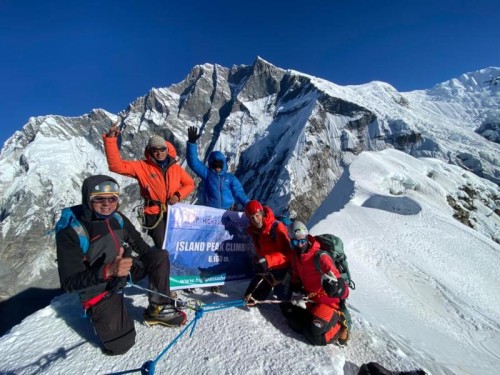


 USD 2250
USD 2250